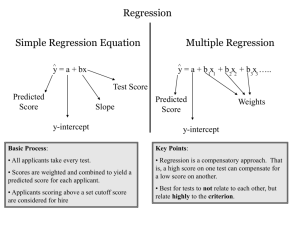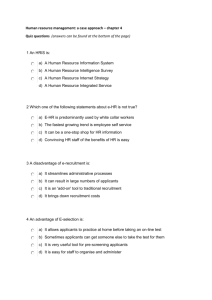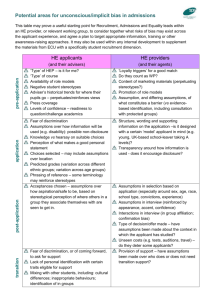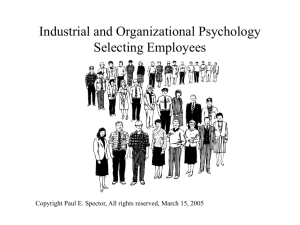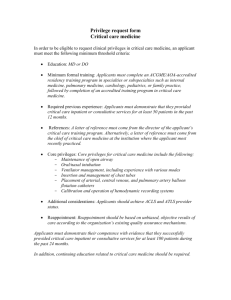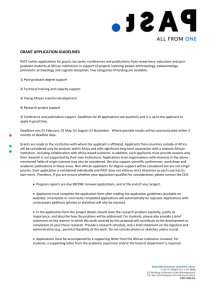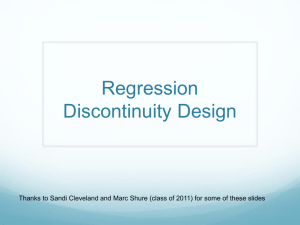Personnel Decision Slides
advertisement
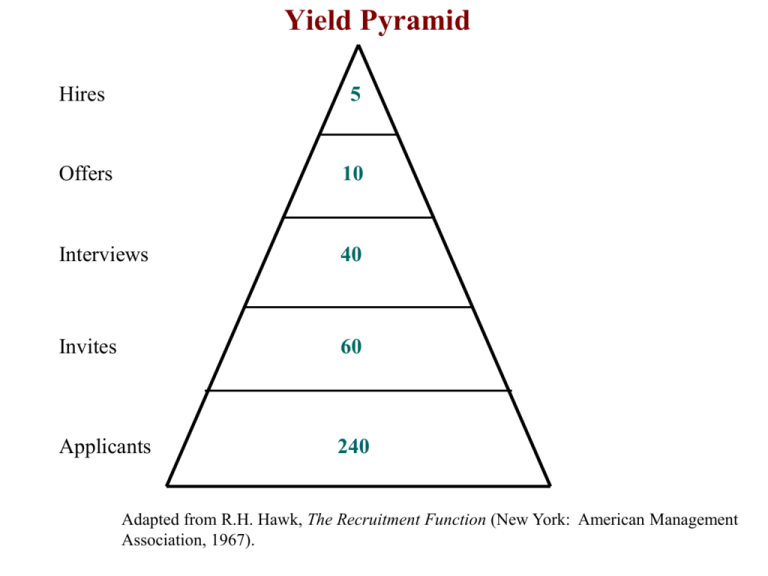
Yield Pyramid Hires 5 Offers 10 Interviews 40 Invites 60 Applicants 240 Adapted from R.H. Hawk, The Recruitment Function (New York: American Management Association, 1967). Recruitment Sources (Techniques) • In-House (e.g., hiring or promotion from within the organization) • Newspapers, Trade/Professionals Publications • Outside Companies (Headhunters, Employment/Temp Agencies, Executive Search Firms • Job or College Fairs • Internet-based • Private sites (e.g., Monster) • Professional Organizations • Company web site Some Factors in Considering Recruiting Sources • Cost • Time Requirements • Number and Quality of Applicants • Type of Job (e.g., manual labor, managerial) • Type of Applicant (knowledge, skills, demographic and minority representation) Other Recruitment Issues Recruiter Characteristics --• Demographics (e.g., gender, race, age) • Functional job area (similarity to job being recruited) • Personality (e.g., warmth, enthusiasm, supportive, personable) Administration of Recruitment --• Promptness of follow-up contact (short timeframe is best) • Amount of information requested of applicant (more information = less # of applicants) Organizational Emphasis on Recruitment • Money and time spent on recruiting by HR = 16% • Evaluation of recruitment effectiveness (often limited to criteria such as meeting deadlines) • Extent of recruiter training (most not trained; less than half of organizations used formal, standardized training programs) Realistic Job Preview Effects PERCEPTION OF HONESTY AND CARING RJP VACCINATION OF EXPECTATIONS ROLE CLARITY COPING MECHANISMS DEVELOP FOR NEW JOBS SELF SELECTION INTERNAL FOCUS OF CONTROL COMMITMENT TO CHOICE OF ORGANIZATION NEEDS ARE MATCHED TO ORGANIZATIONAL CLIMATE JOB SATISFACTION JOB PERFORMANCE VOLUNTARY TURNOVER INVOLUNTARY TURNOVER TENURE IN THE ORGANIZATION Realistic Job Preview!!! Men wanted for hazardous journey. Low wages, bitter cold, long hours of complete darkness. Safe return doubtful. Honour and recognition in event of success. ~ Ernest Shackleton's advertisement for 1914 Trans-Antarctic Expedition Test Utility Key Points Selection Ratio (SR) = Job openings n N Applicants Test Validity [Criterion-related]: The extent to which test scores correlate with job performance scores [Range is from 0 to 1.0] Proportion of “Successes” Expected Through the Use of Test of Given Validity and Given Selection Ratio, for Base Rate .60. (From Taylor & Russell, 1939, p. 576) Selection Ratio (SR) Validity .05 .10 .20 .30 .40 .50 .60 .70 .80 .90 .95 .00 .05 .10 .15 .20 .60 .64 .68 .71 .75 .60 .63 .67 .70 .73 .60 .63 .65 .68 .71 .60 .62 .64 .67 .69 .60 .62 .64 .66 .67 .60 .62 .63 .65 .66 .60 .61 .63 .64 .65 .60 .61 .62 .63 .64 .60 .61 .61 .62 .63 .60 .60 .61 .61 .62 .60 .60 .60 .60 .61 .25 .30 .35 .40 .45 .78 .82 .85 .88 .90 .76 .79 .82 .85 .87 .73 .76 .78 .81 .83 .71 .73 .75 .78 .80 .69 .71 .73 .75 .77 .68 .69 .71 .73 .74 .66 .68 .69 .70 .72 .65 .66 .67 .68 .69 .63 .64 .65 .66 .66 .62 .62 .63 .63 .64 .61 .61 .62 .62 .62 .50 .55 .60 .65 .70 .93 .95 .96 .98 .99 .90 .92 .94 .96 .97 .86 .88 .90 .92 .94 .82 .84 .87 .89 .91 .79 .81 .83 .85 .87 .76 .78 .80 .82 .84 .73 .75 .76 .78 .80 .70 .71 .73 .74 .75 .67 .68 .69 .70 .71 .64 .64 .65 .65 .66 .62 .62 .63 .63 .63 .75 .80 .85 .90 .95 1.00 .99 1.00 1.00 1.00 1.00 1.00 .99 .99 1.00 1.00 1.00 1.00 .96 .98 .99 1.00 1.00 1.00 .93 .95 .97 .99 1.00 1.00 .90 .92 .95 .97 .99 1.00 .86 .88 .91 .94 .97 1.00 .81 .83 .86 .88 .92 1.00 .77 .78 .80 .82 .84 .86 .71 .72 .73 .74 .75 .75 .66 .66 .66 .67 .67 .67 .63 .63 .63 .63 .63 .63 Note: A full set of tables can be found I Taylor and Russell (1939) and in McCormick and Ilgen (1980, Appendix B). Selection Ratio Example Mean Standard Criterion Score of Accepted Cases in Relation to Test Validity and Selection Ratio (From Brown & Ghiselli, 1953, p. 342) Validity Coefficient Selection Ratio .00 .05 .10 .15 .20 .25 .30 .35 .40 .45 .50 .55 .60 .65 .70 .75 .80 .85 .90 .95 1.00 .05 .10 .15 .20 .25 .30 .35 .40 .45 .50 .50 .60 .65 .70 .75 .80 .85 .90 .95 .00 .00 .00 .00 .00 .00 .00 .00 .00 .00 .00 .00 .00 .00 .00 .00 .00 .00 .00 .10 .09 .08 .07 .06 .06 .05 .05 .04 .04 .04 .03 .03 .02 .02 .02 .01 .01 .01 .21 .18 .15 .14 .13 .12 .11 .10 .09 .08 .07 .06 .06 .05 .04 .04 .03 .02 .01 .31 .26 .23 .21 .19 .17 .16 .15 .13 .12 .11 .10 .09 .07 .06 .05 .04 .03 .02 .42 .35 .31 .28 .25 .23 .21 .19 .18 .16 .14 .13 .11 .10 .08 .07 .05 .04 .02 .52 .44 .39 .35 .32 .29 .26 .24 .22 .20 .18 .16 .14 .12 .11 .09 .07 .05 .03 .62 .53 .46 .42 .38 .35 .32 .29 .26 .24 .22 .19 .17 .15 .13 .11 .08 .06 .03 .73 .62 .54 .49 .44 .40 .37 .34 .31 .28 .25 .23 .20 .17 .15 .12 .10 .07 .04 .83 .70 .62 .56 .51 .46 .42 .39 .35 .32 .29 .26 .23 .20 .17 .14 .11 .08 .04 .94 .79 .70 .63 .57 .52 .48 .44 .40 .36 .32 .29 .26 .22 .19 .16 .12 .09 .05 1.04 .88 .77 .70 .63 .58 .53 .48 .44 .40 .36 .32 .28 .25 .21 .18 .14 .10 .05 1.14 .97 .85 .77 .70 .64 .58 .53 .48 .44 .40 .35 .31 .27 .23 .19 .15 .11 .06 1.25 1.05 .93 .84 .76 .69 .63 .58 .53 .48 .43 .39 .34 .30 .25 .21 .16 .12 .07 1.35 1.14 1.01 .91 .82 .75 .69 .63 .57 .52 .47 .42 .37 .32 .27 .22 .18 .13 .07 1.46 1.23 1.08 .98 .89 .81 .74 .68 .62 .56 .50 .45 .40 .35 .30 .25 .19 .14 .08 1.56 1.32 1.16 1.05 .95 .87 .79 .73 .66 .60 .54 .48 .43 .37 .32 .26 .20 .15 .08 1.66 1.41 1.24 1.12 1.01 .92 .84 .77 .70 .64 .58 .52 .46 .40 .33 .28 .22 .16 .09 1.77 1.49 1.32 1.19 1.08 .98 .90 .82 .75 .68 .61 .55 .48 .42 .36 .30 .23 .17 .09 1.87 1.58 1.39 1.26 1.14 1.04 .95 .87 .79 .72 .65 .58 .51 .45 .38 .32 .25 .18 .10 1.98 1.67 1.47 1.33 1.20 1.10 1.00 .92 .84 .76 .68 .61 .54 .47 .40 .33 .26 .19 .10 2.08 1.76 1.55 1.40 1.27 1.16 1.06 .97 .88 .80 .72 .64 .57 .50 .42 .35 .27 .20 .11 Basic Orientation Principles 1) The 1st day on the job is crucial! It is important to manage it well and make it a positive time. Employees remember it for years, particularly if it is an unpleasant experience 2) Impressions formed during the first 60-90 days are difficult to alter. So, it is important to make this time a positive experience for newly-hired employees 3) Ensure that new employees see how their job fits within the framework of the overall organization. (As such, the organization needs to communicate information about it’s goals and objectives) 4) Avoid ‘information overload.” It’s best to provide the new employee with information in reasonable amounts and in a meaningful sequence 5) Ensure that the new employee’s immediate supervisor is ultimately responsible for the orientation program 6) Social and family adjustment concerns should be addressed in the orientation program Regression Simple Regression Equation Multiple Regression y = a + b 1x1 + b2x2 + b3x3 ….. y = a + bx Test Score Predicted Score Slope y-intercept Predicted Score y-intercept Basic Process: • All applicants take every test. • Scores are weighted and combined to yield a predicted score for each applicant. • Applicants scoring above a set cutoff score are considered for hire Key Points: • Regression is a compensatory approach. That is, a high score on one test can compensate for a low score on another. • Best for tests to not relate to each other, but relate highly to the criterion. Weights Compensatory Example How Four Job Applicants with Different Predictor Scores Can Have the Same Predicted Criterion Score Using Multiple Regression Analysis Applicant Score on X Score on X 1 2 Predicted Criterion Score A 25 0 100 B 0 50 100 C 20 10 100 D 15 20 100 Note: Based on the equation Y = 4X + 2X. 1 2 Independent Predictors r r 1c Predictor 1 2c Criterion Predictor 2 R2 = r 2 1c c.12 For example, if r = .60 and r 1c +r 2 2c = .50, then 2c 2 R c.12 = 2 2 (.60) + (.50) = .36 + .25 = .61 Interrelated Predictors Criterion r r 1c 2c r 12 Predictor 1 2 Predictor 2 2 r 1c r 2c - 2r 12r 1cr 2c 2 R c.12 = 1 - r2 12 For example, if the two predictors intercorrelate .30, given the validity coefficients from the previous example And r = .30, we will have 12 2 2 R c.12 = 2 (.60) + (.50) - 2(.30)(.60)(.50) 1 – (.30)2 = .47 Multiple Cutoff Approach WAB Paper & Pencil Math Test Paper & Pencil Aptitude Test 100 x 100 x 100 Pass Pass Pass Cutoff score Cutoff score x Cutoff score Fail Fail Fail 0 0 0 Basic Process: • All applicants take every test. • Applicant must achieve a passing score on every test to be considered for hire. Key Point: A multiple cut-off approach can lead to different decisions regarding who to hire versus using a regression approach. Multiple Hurdle Approach Paper & Pencil Knowledge Test Pass Interview 100 xxxxx xxxxx Pass 100 xxxxx xx xxx xxx Eliminated from the selection process 0 100 xxx Pass Cutoff score Cutoff score Fail Work Sample Test Eliminated from the selection process xxx Fail Fail xxx 0 Eliminated from the selection process Cutoff score 0 Basic Process: • All applicants take the 1st test. • Pass/fail decisions are made on the 1st and subsequent tests and only those who pass can continue on to the next test [a sequential process]. Key Point: Useful when a lengthy, costly, and complex training process is required for the position. Banding Basic concept: Small differences in test scores might reasonably be due to measurement error. Therefore, you do not want small differences in test scores to trump all other consideration in ranking individuals in hiring.” (p. 82). Banding (cont.) SED Banding Types Both use the top score to establish the top of the band Fixed 98 .. 94 . 92 .. 88 .. . .. All those from the band are selected before those from the lower band Example of a band of 6 points Sliding 98 . 94 ... 92 . .. 88 .. . .. Bands slide down after each person is removed from the top (bands re-established)
